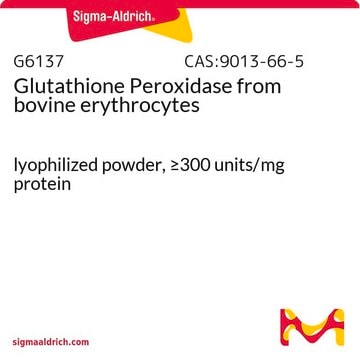GRSA
Glutathione Reductase Assay Kit
Sufficient for 100 colorimetric tests
Synonym(s):
Glutathione Reductase Activity Assay Kit
Sign Into View Organizational & Contract Pricing
All Photos(2)
About This Item
UNSPSC Code:
12161503
NACRES:
NA.28
Recommended Products
General description
Glutathione reductase (GR) is a ubiquitous enzyme that catalyzes the reduction of oxidized glutathione (GSSG) to glutathione (GSH). Glutathione reductase is essential for the glutathione redox cycle that maintains adequate levels of reduced cellular GSH, which serves as an antioxidant reacting with free radicals and organic peroxides. Glutathione is also a substrate for the glutathione peroxidases and glutathione S-transferases in the detoxification of organic peroxides and the metabolism of xenobiotics.
Application
Glutathione Reductase Assay Kit has been used to measure the activity of glutathione reductase as a part of oxidative stress assessment and also to study the effects of antifouling biocides on it.
Biochem/physiol Actions
Glutathione reductase (EC 1.6.4.2) (GR) is a ubiquitous enzyme that catalyzes the reduction of oxidized glutathione (GSSG) to glutathione (GSH). Glutathione reductase is essential for the glutathione redox cycle that maintains adequate levels of reduced cellular GSH, which serves as an antioxidant reacting with free radicals and organic peroxides. Glutathione is also a substrate for the glutathione peroxidases and glutathione S-transferases in the detoxification of organic peroxides and the metabolism of xenobiotics. This kit contains reagents for the spectrophotometric determination of glutathione reductase activity either by following the decrease in absorbance caused by the oxidation of NADPH at 340 nm (UV assay) or the increase in absorption caused by the reduction of dithiobis(2-nitrobenzoic acid) (DTNB) at 412 nm (colorimetric assay). This kit provides reagents for a spectrophotometric assay for measuring the activity of glutathione reductase either by following the decrease in A340 caused by the oxidation of NADPH or the increase in A412 caused by the reduction of dithiobis(2-nitrobenzoic acid).
This kit provides reagents for a spectrophotometric assay for measuring the activity of glutathione reductase either by following the decrease in A340 caused by the oxidation of NADPH or the increase in A412 caused by the reduction of dithiobis(2-nitrobenzoic acid).
Suitability
Suitable for the measurement of glutathione reductase activity in biological samples
Principle
This kit contains reagents for the spectrophotometric determination of glutathione reductase activity either by following the decrease in absorbance caused by the oxidation of NADPH at 340 nm (UV assay) or the increase in absorption caused by the reduction of dithiobis(2-nitrobenzoic acid) (DTNB) at 412 nm (colorimetric assay). This kit provides reagents for a spectrophotometric assay for measuring the activity of glutathione reductase either by following the decrease in A340 caused by the oxidation of NADPH or the increase in A412 caused by the reduction of dithiobis(2-nitrobenzoic acid).
Analysis Note
UV assay: One unit will cause the oxidation of 1.0 μmole of NADPH at 25 °C at pH 7.5.
Colorimetric assay: One unit will cause the reduction of 1.0 μmole of DTNB to TNB at 25 °C at pH 7.5.
Colorimetric assay: One unit will cause the reduction of 1.0 μmole of DTNB to TNB at 25 °C at pH 7.5.
Storage Class Code
10 - Combustible liquids
Flash Point(F)
Not applicable
Flash Point(C)
Not applicable
Certificates of Analysis (COA)
Search for Certificates of Analysis (COA) by entering the products Lot/Batch Number. Lot and Batch Numbers can be found on a product’s label following the words ‘Lot’ or ‘Batch’.
Already Own This Product?
Find documentation for the products that you have recently purchased in the Document Library.
Customers Also Viewed
Toxicity effects of an environmental realistic herbicide mixture on the seagrass Zostera noltei
Diepens NJ, et al.
Environmental Pollution (Barking, Essex : 1987), 222, 393-403 (2017)
A comparative cytotoxicity study of TiO 2 nanoparticles under light and dark conditions at low exposure concentrations
Dalai S, et al.
Toxicology Research, 1(2), 116-130 (2012)
Karl W Engel et al.
Journal of biophotonics, 9(11-12), 1148-1156 (2016-07-09)
Photobiomodulation (PBM) therapy has been noted to promote cell proliferation and growth in many different cell types shown both in vitro and in vivo. Currently, treatment regimens are used in the clinic for a variety of ailments, including wound healing.
V M Factor et al.
The Journal of biological chemistry, 273(25), 15846-15853 (1998-06-23)
In previous studies we have demonstrated that transforming growth factor (TGF)-alpha/c-myc double transgenic mice exhibit an enhanced rate of cell proliferation, accumulate extensive DNA damage, and develop multiple liver tumors between 4 and 8 months of age. To clarify the
Glutathione: Chemical, Biochemical and Metabolic Aspects.
Dolphin D., et al.
Glutathione: Chemical, Biochemical and Metabolic Aspects (1989)
Our team of scientists has experience in all areas of research including Life Science, Material Science, Chemical Synthesis, Chromatography, Analytical and many others.
Contact Technical Service






